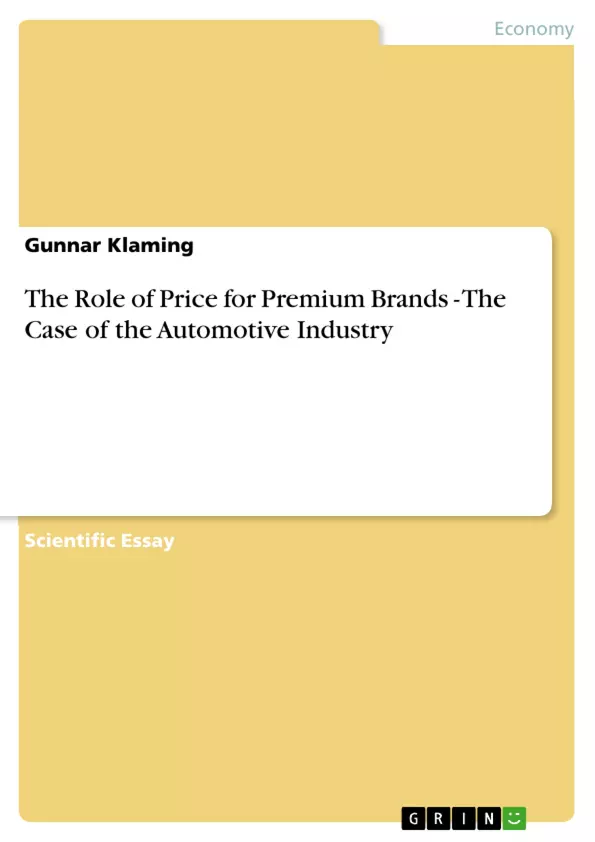Starting situation
Today, many markets have reached such a degree of saturation that market potential is often virtually exhausted. Increasingly, growth can be achieved only at the expense of competitors. Increasing internationalization and the market entry by new competitors result in brand and product inflation. Dramatically shorter product life cycles and constantly accelerating product aging are another challenge for companies that they must deal with.2
Hence, in order to make a company’s products stand out from the diverse range available, suppliers are attempting to hone competitive edge through increasing differentiation of their brands, emphasizing how they meet the specific needs and wants of their target customer groups and market segments. The overall goal of this approach is to build up brands that are unique in the market place – brands that promise a unique value. A strong brand can reach high rates of loyalty among existing customers; it can “more easily” gain new customers, due to its characteristic position; and it can therefore charge a premium price. Marketers have several means to work with in order to reach this goal. Generally, the corporate strategy “might specify a premium position or a massmerchandiser/ discount approach. These obviously have direct impact on the pricing”3. Price is only one of the marketing variables, but for the case of premium brands it is important. The pricing position is one determinant for the development of a brand identity, incidentally, not only among customers and potential customers, but also among society, employees, etc.). As part of the company’s target market and positioning objectives (that largely determine the pricing strategy) price reflects the quality of the branded product and likewise the prestige that the user gains through this brand. In this paper it will be shown, which role pricing plays in the brand concept of premium cars and what the case of the cars says about the theory and practice of premium brands.
Inhaltsverzeichnis (Table of Contents)
- 1 Starting situation
- 2 Definitions
- 2.1 Pricing
- 2.1.1 Pricing as part of the marketing mix
- 2.1.2 Pricing approaches
- 2.2 Brands
- 2.2.1 Role of the brand
- 2.2.2 Premium brand
- 2.3 Pricing of premium brands
- 3 Pricing of premium cars
- 3.1 The case of BMW - History, structure, goals
- 3.2 BMW in context of other companies in the automotive industry
- 3.3 Pricing of premium cars
- 4 Synopsis What does the case of the cars say about the theory of premium brands and in what way is it special
Zielsetzung und Themenschwerpunkte (Objectives and Key Themes)
This paper explores the role of pricing in the brand concept of premium cars, analyzing the case of BMW within the broader context of the automotive industry. It aims to demonstrate how pricing contributes to the development and perception of premium brands, specifically focusing on the unique characteristics of this industry.
- Pricing strategies and their influence on brand perception
- The relationship between price and perceived value in premium brands
- The role of branding in achieving a premium positioning and price strategy
- The case of BMW as a prominent example of premium brand strategy
- The unique aspects of pricing in the automotive industry compared to other sectors
Zusammenfassung der Kapitel (Chapter Summaries)
The first chapter establishes the context for the study, highlighting the increasing market saturation and the need for differentiation in today's competitive landscape. The paper emphasizes the importance of building unique brands with strong customer loyalty to secure a premium price. Chapter two defines key concepts such as pricing, branding, and premium brands, explaining their roles within the marketing mix and the broader business strategy. Chapter three delves into the specific case of BMW, exploring its history, structure, goals, and position within the automotive industry. This chapter also examines the pricing strategies used by BMW and other premium car manufacturers. The concluding chapter summarizes the findings and discusses how the case of BMW exemplifies the theory and practice of premium brand strategies.
Schlüsselwörter (Keywords)
This paper focuses on the role of pricing in creating and maintaining premium brand value in the automotive industry. Key terms and concepts include pricing strategies, brand positioning, premium branding, perceived value, customer loyalty, differentiation, and the case study of BMW. The paper analyzes the interplay between price and brand identity, particularly in the context of a saturated market and increasing competition. It also examines the unique challenges and opportunities presented by the automotive industry in terms of branding and pricing.
- Arbeit zitieren
- Gunnar Klaming (Autor:in), 2006, The Role of Price for Premium Brands - The Case of the Automotive Industry, München, GRIN Verlag, https://www.grin.com/document/52094



